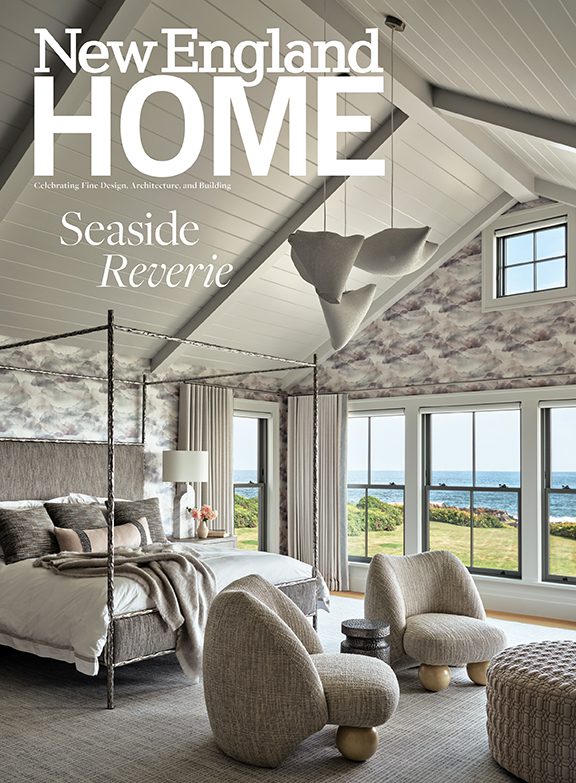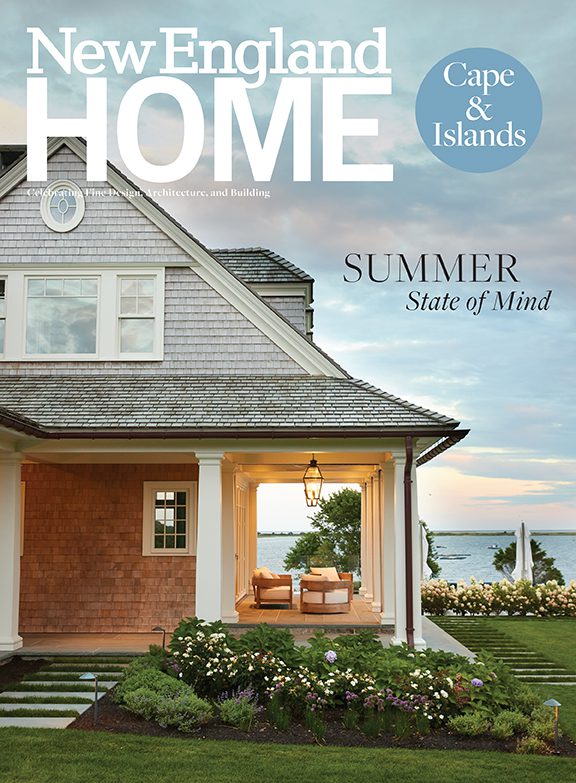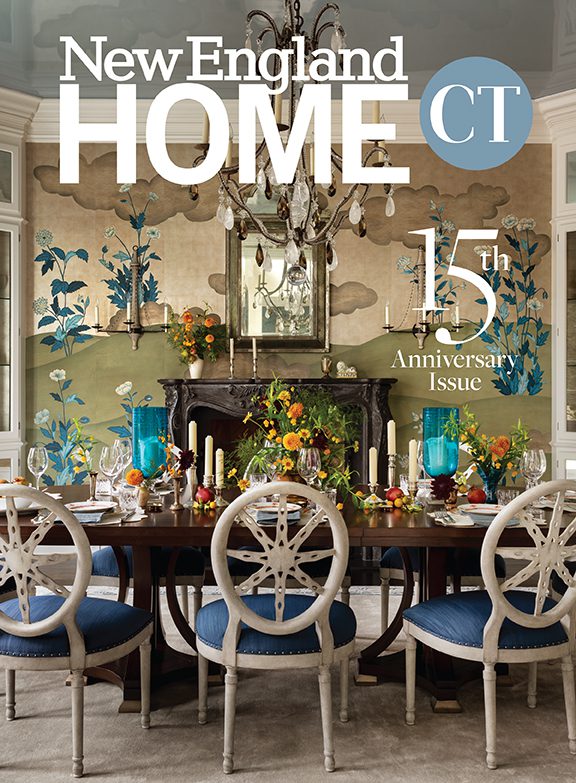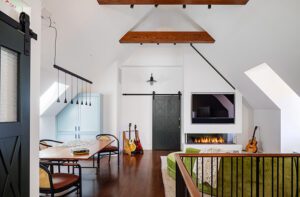Refresher Course
July 1, 2010
Text by Stacy Kunstel Photography by Bruce Buck
Interior designer Charles Spada has never been flash-in-the-pan. Meticulous? Yes. Exacting? Check. A perfectionist? Certainly, ever since his earliest work as a fashion designer in New York.
The proof is on the page. The photos of this residence, designed twenty years ago and recently updated, show the timeless aspect of his work.
Sited at the mouth of the Connecticut River in Essex, Connecticut, and blessed with a wide view of Long Island Sound, the house was purchased in the 1980s by a couple keenly aware they would never want to leave. Nestled into privacy behind a well-groomed hedge, the lovely piece of land is hugged by gardenscapes and bordered by beautiful vistas.
Twenty years ago, Spada took the historic Greek Revival house down to its very roots and then built upon them stately columns, moldings and trim. Window casings were outfitted with broad-shouldered frames, leaving the views exposed. The fireplace mantel in the living room took on a broken geometry grounded in period Dutch influences. The renovation turned a porch into a library that looked ages old and created a serene master suite in what were probably once maids’ quarters.
Spada reversed the direction of the staircase, expanding the gracious feel of the foyer while adding a hint of intrigue by giving visitors a framed view of the garden outside. Walls were redone in plaster, woodwork painted in white with a perfect sheen.
So when the clients called recently, it wasn’t to talk about major renovations—everything had been done right the first time—they just wanted a little refresher now that two decades had exerted their wear-and-tear on fabrics and finishes. A new porch on the back of the house just off the breakfast area and kitchen might be nice, too, they thought.
“What you see is essentially what was done twenty years ago,” says Spada. “They’re the sort of clients every designer should have at least once in their life. They’re very smart about it,” he says of the well-traveled couple who make this house their primary residence.
This was not a house that needed a major facelift. The bones, the plaster walls, the floors of light wood and the antique furnishings had all held up to the highest standards. But with a few changed fabrics, a few cued colors, the house was brought into the twenty-first century.
“I’m a very classic decorator,” says Spada, “but it’s clean and updated.”
The sunlight streaming through the purposely unadorned windows in the living room had left the upholstery faded. Spada used that fact as an opportunity to scrub the space of its vibrant jewel-toned chintz in favor of a palette of more demure greens. Off came the chocolate linen covering the pair of Louis XVI armchairs and on went cool stried silk chartreuse. An armchair’s large floral pattern was switched out for a more muted woven green fabric, rounding out a range of greens in linens, silks and cottons. It signals the slightest departure from today’s requisite palette of beige to evoke serenity, picking up—subtly—on the colors of the outdoors.
A rug from Steven King now sits under the custom glass-topped coffee table Spada had designed on the first go-around. “The rug has all the colors of the room in it, reduced by a 1,000 percent,” the designer says.
“I’m not one for making it look like a patchwork quilt,” he says of the subdued patterns and colors on fabrics throughout the house.
Across from the downy sofa an intricate molding design plays out above and surrounding the fireplace. The inviting club chair and ottoman covered in green flecked with a rhubarb-hued dot lies in wait of an eager magazine reader. The fireplace design was the result of Spada’s research on the connection between the American period moldings and Dutch moldings. “After much research I incorporated a Dutch-American facet to it,” he says.
On the opposite end of the room, framed intaglios—long a Spada signature—float on wires hanging from picture molding rods behind a grand piano. Two flame-stitch-covered chairs from the Netherlands embrace an eighteenth-century Italian commode with a carefully placed mirror of the same era above it. Many of the home’s antiques were handpicked by Spada on his extensive travels for clients and his Boston Design Center showroom, Antiques on 5, and have only improved with age.
“A point I’ve said many times before: you cut corners and it shows in a year or two,” says Spada. “We want quality. We don’t want to be aggravated with having to do over anything. Quality needs to be stressed. The amount of money wasted in achieving a ‘look’ is just wasted.”
That said, the library, painted the color of a ready-to-pick French string bean during the original renovation, retains its vibrant hue. There was no sense in meddling with it. New curtains in Italian silk hang at the windows. The dining room floor, painted to look like period inlay, was repainted in the same fashion, as was the checkerboard-painted floor in the foyer in front of the staircase.
The master suite got a striking new rug, again from Steven King, that pulls together all the blues, greens and taupes from the linen-covered headboard and the custom bedding by Muse.
“It’s all very carefully selected,” the designer says. “I don’t like beds that aren’t custom made. I like custom upholstery headboards.”
Amid the simple elegance of the design, one finds whimsy in the form of a sweet pink room once used by the couple’s children for sleepovers. Twin beds now wear new layers of quilts and linen-covered headboards, sheer curtains hang at the windows, and a grasscloth rug is a fresh new touch for the floor. Spada placed a milking stool in its original paint at the end of each bed. “There’s a playfulness and practicality to them,” he says of the stools, which he envisioned holding wet towels. “I found them in that color. I rarely tamper with things like that. I don’t want it to all look new. I like that they look like they had a relationship with the house.”
Like the house, Spada says his own style has evolved. “My work has become more refined, better edited and I am more self-assured in my approach to design,” he says. “I saw the changes as a simple update, a change of fabrics and new colors, something different after twenty years. However, if I could have found the original fabrics I would have used them again.”
For Spada—and the couple lucky enough to call this home—when you choose to do it right, the more the things change, the more they stay the same.
Interior Design and Interior Architecture: Charles Spada
Share
![NEH-Logo_Black[1] NEH-Logo_Black[1]](https://b2915716.smushcdn.com/2915716/wp-content/uploads/2022/08/NEH-Logo_Black1-300x162.jpg?lossy=1&strip=1&webp=1)



















You must be logged in to post a comment.